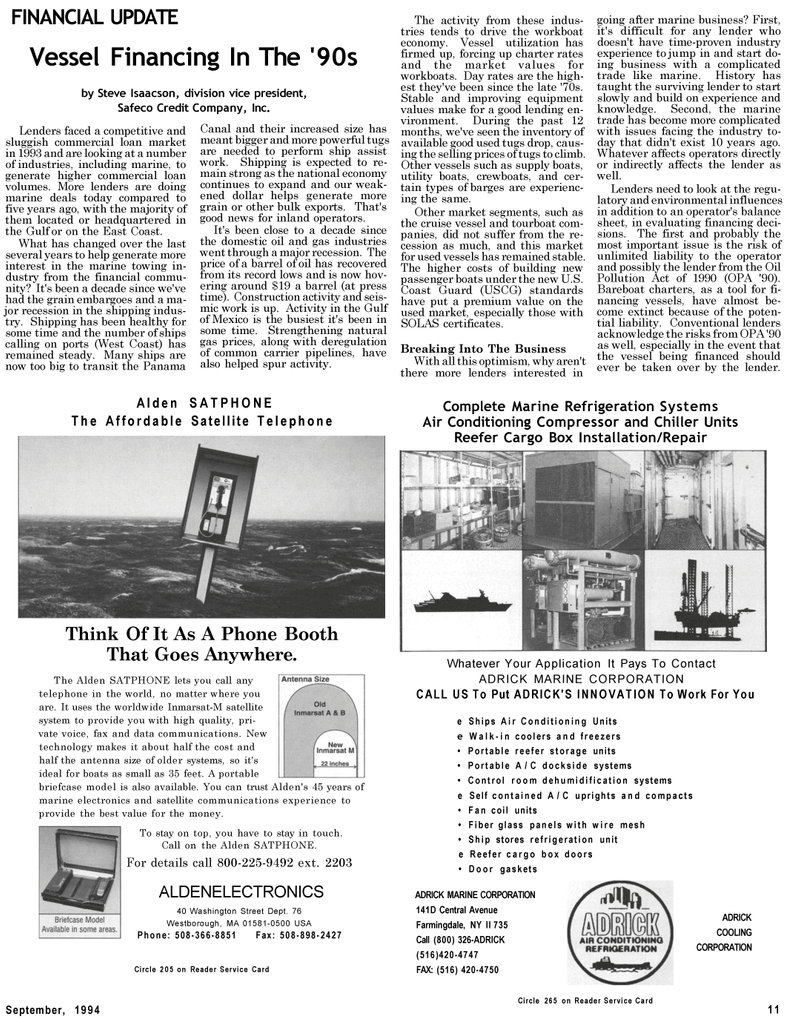
Page 9: of Maritime Reporter Magazine (September 1994)
Read this page in Pdf, Flash or Html5 edition of September 1994 Maritime Reporter Magazine
FINANCIAL UPDATE
Vessel Financing In The '90s by Steve Isaacson, division vice president,
Safeco Credit Company, Inc.
Lenders faced a competitive and sluggish commercial loan market in 1993 and are looking at a number of industries, including marine, to generate higher commercial loan volumes. More lenders are doing marine deals today compared to five years ago, with the majority of them located or headquartered in the Gulf or on the East Coast.
What has changed over the last several years to help generate more interest in the marine towing in- dustry from the financial commu- nity? It's been a decade since we've had the grain embargoes and a ma- jor recession in the shipping indus- try. Shipping has been healthy for some time and the number of ships calling on ports (West Coast) has remained steady. Many ships are now too big to transit the Panama
Canal and their increased size has meant bigger and more powerful tugs are needed to perform ship assist work. Shipping is expected to re- main strong as the national economy continues to expand and our weak- ened dollar helps generate more grain or other bulk exports. That's good news for inland operators.
It's been close to a decade since the domestic oil and gas industries went through a major recession. The price of a barrel of oil has recovered from its record lows and is now hov- ering around $19 a barrel (at press time). Construction activity and seis- mic work is up. Activity in the Gulf of Mexico is the busiest it's been in some time. Strengthening natural gas prices, along with deregulation of common carrier pipelines, have also helped spur activity.
The activity from these indus- tries tends to drive the workboat economy. Vessel utilization has firmed up, forcing up charter rates and the market values for workboats. Day rates are the high- est they've been since the late '70s.
Stable and improving equipment values make for a good lending en- vironment. During the past 12 months, we've seen the inventory of available good used tugs drop, caus- ing the selling prices of tugs to climb.
Other vessels such as supply boats, utility boats, crewboats, and cer- tain types of barges are experienc- ing the same.
Other market segments, such as the cruise vessel and tourboat com- panies, did not suffer from the re- cession as much, and this market for used vessels has remained stable.
The higher costs of building new passenger boats under the new U.S.
Coast Guard (USCG) standards have put a premium value on the used market, especially those with
SOLAS certificates.
Breaking Into The Business
With all this optimism, why aren't there more lenders interested in going after marine business? First, it's difficult for any lender who doesn't have time-proven industry experience to jump in and start do- ing business with a complicated trade like marine. History has taught the surviving lender to start slowly and build on experience and knowledge. Second, the marine trade has become more complicated with issues facing the industry to- day that didn't exist 10 years ago.
Whatever affects operators directly or indirectly affects the lender as well.
Lenders need to look at the regu- latory and environmental influences in addition to an operator's balance sheet, in evaluating financing deci- sions. The first and probably the most important issue is the risk of unlimited liability to the operator and possibly the lender from the Oil
Pollution Act of 1990 (OPA '90).
Bareboat charters, as a tool for fi- nancing vessels, have almost be- come extinct because of the poten- tial liability. Conventional lenders acknowledge the risks from OPA '90 as well, especially in the event that the vessel being financed should ever be taken over by the lender.
Alden SATPHONE
The Affordable Satellite Telephone
Think Of It As A Phone Booth
That Goes Anywhere.
The Alden SATPHONE lets you call any telephone in the world, no matter where you are. It uses the worldwide Inmarsat-M satellite system to provide you with high quality, pri- vate voice, fax and data communications. New technology makes it about half the cost and half the antenna size of older systems, so it's ideal for boats as small as 35 feet. A portable briefcase model is also available. You can trust Alden's 45 years of marine electronics and satellite communications experience to provide the best value for the money.
To stay on top, you have to stay in touch.
Call on the Alden SATPHONE.
For details call 800-225-9492 ext. 2203
ALDENELECTRONICS 40 Washington Street Dept. 76
Westborough, MA 01581-0500 USA
Phone: 508-366-8851 Fax: 508-898-2427
Circle 205 on Reader Service Card
Complete Marine Refrigeration Systems
Air Conditioning Compressor and Chiller Units
Reefer Cargo Box Installation/Repair
Whatever Your Application It Pays To Contact
ADRICK MARINE CORPORATION
CALL US To Put ADRICK'S INNOVATION To Work For You e Ships Air Conditioning Units e Walk-in coolers and freezers • Portable reefer storage units • Portable A/C dockside systems • Control room dehumidification systems e Self contained A/C uprights and compacts • Fan coil units • Fiber glass panels with wire mesh • Ship stores refrigeration unit e Reefer cargo box doors • Door gaskets
ADRICK MARINE CORPORATION 141D Central Avenue
Farmingdale, NY ll 735
Call (800) 326-ADRICK (516)420-4747
FAX: (516) 420-4750
ADRICK
COOLING
CORPORATION
September, 1994 Circle 265 on Reader Service Card 11

 8
8

 10
10
